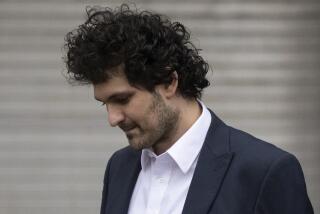Keating Made Lincoln S&L; a Ponzi Scheme, Jury Told
- Share via
Charles H. Keating Jr. pushed the “steady drumbeat” of his company’s bond sales even though he knew that his company was financially troubled, a prosecutor told jurors Wednesday in Keating’s securities fraud trial.
Six months before Lincoln Savings & Loan and its parent company collapsed, the combined operation became a giant Ponzi scheme as it turned to its only source of money--proceeds from bond sales--to pay off earlier bonds, Deputy Dist. Atty. William Hodgman said in opening statements.
But Keating’s lawyer, Stephen C. Neal, challenged the prosecutor’s remarks, telling the Los Angeles Superior Court jury that Keating hired the “best legal and best accounting help” to make sure everything was done in “absolute compliance with the laws.”
Thus began the first criminal trial stemming from the April, 1989, failure of Irvine-based Lincoln and its parent, American Continental Corp. of Phoenix. Lincoln is the nation’s biggest thrift failure to date, costing taxpayers an estimated $2.6 billion.
The tall, dapper Keating, stoic as he sat in the courtroom, is accused in 20 counts of defrauding 22 small investors who bought a total of $1.8 million in American Continental bonds at Lincoln’s Southern California branches.
They are among thousands of investors--most of them Lincoln customers--who lost more than $250 million in the collapse of Keating’s financial empire.
As cameras clicked in the crowded courtroom Wednesday, Hodgman outlined his case for proving that Keating aided and abetted bond sellers by providing misleading information that caused them to make false statements and omit material information for customers.
Keating, he said, controlled nearly all activities at American Continental and Lincoln, passing on the good news to bond sellers but withholding the bad information.
At one point, American Continental sold $500,000 to $700,000 worth of bonds every day to people who knew nothing about Keating’s disputes with regulators, he said. They also didn’t know that regulators had told Keating when the bond sales began in late 1986 that Lincoln was inadequately capitalized.
Neal countered that lawyers and accountants made sure that all material information was disclosed to prospective bond purchasers. He also said Keating resolved his disputes with regulators in a 1988 agreement that gave Lincoln a new financial examination by different government auditors.
He also pointed out that three state and federal agencies met regularly with Lincoln and American Continental executives over the status of the bond sales and never moved to limit or halt the sales.
When Keating realized that he would never get along with thrift regulators, Neal said, he tried to sell the Irvine-based S&L.; But regulators thwarted proposed sales to different groups by imposing unreasonable conditions on the deals, he said.
He urged jurors to “strip away the emotion” in the highly publicized case and focus on the facts, which he said would clear the 67-year-old Keating.
“In the end, when you hear all the evidence, I think you will, as I think you should, give my client back his future; let my client go home,” Neal said.
Testimony begins today, when bondholders Leon and Esther Bonan of Sherman Oaks, who lost $101,000, take the stand.
More to Read
Inside the business of entertainment
The Wide Shot brings you news, analysis and insights on everything from streaming wars to production — and what it all means for the future.
You may occasionally receive promotional content from the Los Angeles Times.








